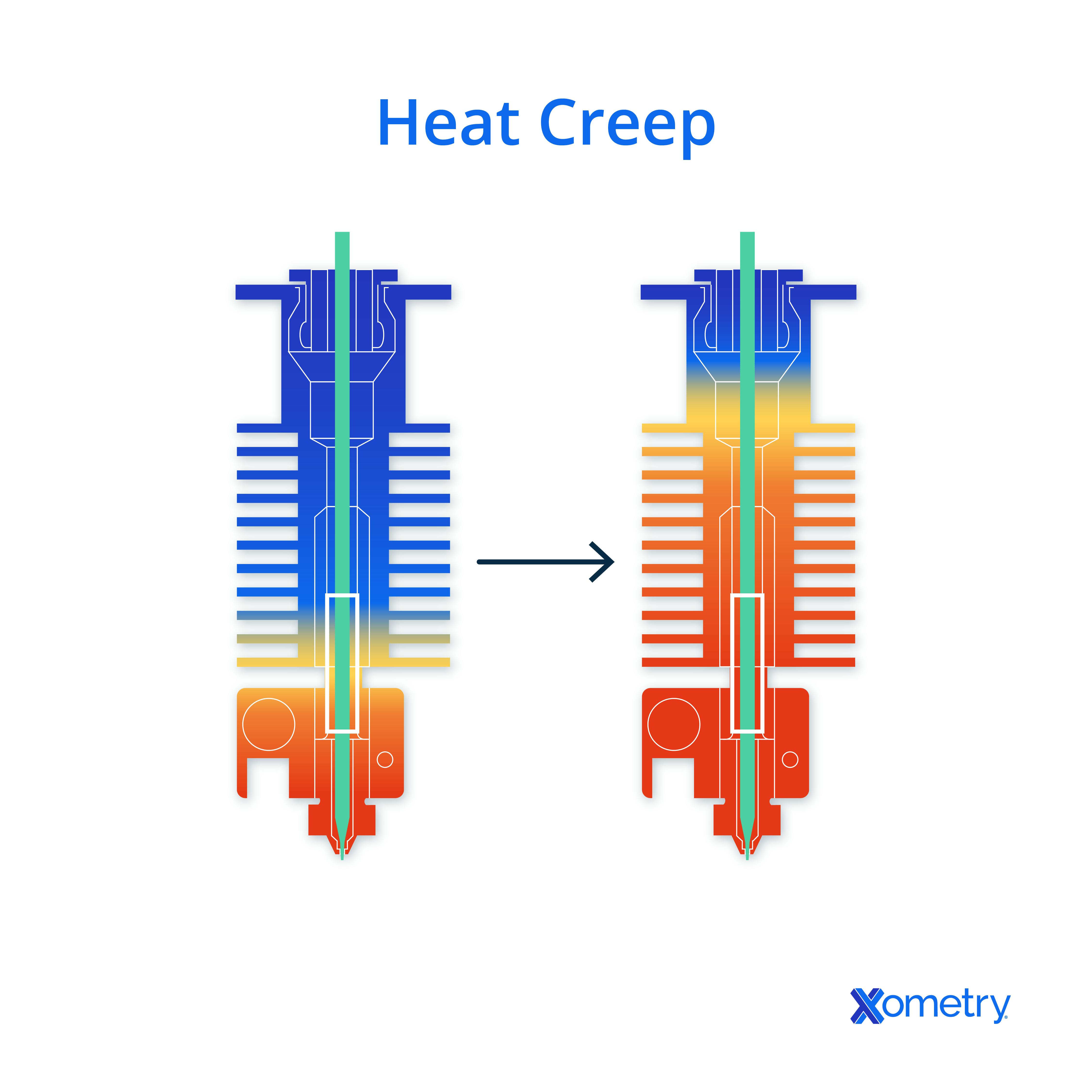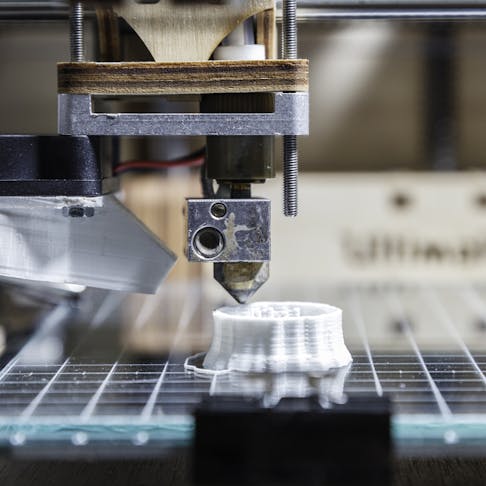Heat creep is a problem that happens in hot extrusion 3D printing processes (FDM (fused deposition modeling) and FFF (fused filament fabrication). It is the unwanted travel of heat up the filament from the hot end. There are a variety of possible causes for this, but several can combine, so it’s important to evaluate all of the well-understood issues. This article will define heat creep in 3D printing, state what causes it, and provide some solutions to prevent it.
What Is Heat Creep in 3D Printing?
Heat creep is the process of unsteady heat transfer throughout the hot end and melts the filament too early, before the melt zone. This results in clogging in some parts, specifically on the extrusion path and the thermal barrier tube. Heat creep has various causes, all of which are controllable to some degree. For more information, see our 3D printing guide.

Listed below are some causes of heat creep in a 3D printer:
1. Hot End Is Overheated
The filament is delivered through an electrical heater that should bring it to the correct extrusion temperature as it is fed through. This device is usually termed the “hot end”. A malfunctioning thermostat (poorly thermally connected to the hot end) or too high a temperature setting can push the temperature in the feeder parts of the print head high enough to prematurely melt the filament.
2. Not Enough Cooling for the Hot End or Broken Cooling Fan
The hot end is cooled by a fan to create a strong temperature gradient up through the print head. If the fan isn’t delivering enough cooling air, heat buildup will reduce the temperature gradient and prematurely melt the filament. This can result from fan speed setting, fan damage, detritus buildup, and other causes.
3. Filament Spends Too Much Time on the Hot End
If the printing progresses slowly or is stopped by another issue, the filament will spend excess time in the hot end, allowing it to melt upwards towards the feeder. This can also indicate that the hot end is running hot, so it may be a symptom rather than a cause of heat creep.
4. The Design of the Hot End
Heat isolation in the hot end is a common design issue. Better-quality extrusion heads will have thermal barriers built into them to increase the localization of heat at the extruder.
5. The Printing Speed Is Insufficient
If the print speed is slow but the heating of the hot end and fan settings are for a faster print speed, then heat buildup will again allow heat to creep up into the filament.
6. Failure of the PTFE Guide Tube
The filament is generally fed to the hot end through a PTFE tube that should isolate it from direct heating until it enters the melt zone. If the guide tube is worn, or misplaced and pushed hard against the hot metal of the print head, then melt can take place in the feeder as the filament is overexposed to heat.
7. Dusty Heat Sink
If the hot end has a heat sink, but it has become obstructed by dirt or pruning detritus, then this will limit air circulation and influence the temperature gradient in the hot end.
Ways to Fix Heat Creep
Listed below are some tips on how to fix heat creep in 3D printing:
1. Boost Printing Efficiency
A print that progresses quickly and contains minimum pause time or slowdowns will reduce the potential for heat creep. With faster printing, the filament will feed through quickly and not have time to overheat above the extruder.
2. Exchange the Hot End
A better-quality hot end can make a big difference to print performance overall, and heat creep in particular. Better fan quality, better-designed heat sinking, and more built-in thermal isolation can all help in solving the problem. It’s particularly true of the lowest-cost machines that benefit significantly from a print head upgrade.
3. Boost Fan Speed
Boosting the fan speed is a simple fix that can make a big difference. It only requires the fan speed to be increased in the machine setup, requiring an adjustment in machine settings. This is the main designed-in element in creating the required temperature gradient in the print head.
4. Reduce the Hot End Temperature
If the hot end temperature is set too high, or the thermocouple is malfunctioning or in poor contact with the extruder metal, then the extruder temperature is going to feed heat upwards and introduce heat creep. Reduce the set point and use an IR thermometer to confirm that the extruder is at the correct temperature and not undergoing wide temperature swings. This will indicate thermocouple issues.
5. The Heat Sink Should Be Cleaned
Basic machine maintenance should include print head cleaning. Make sure you regularly brush away any buildup of dirt or printer detritus that might impede airflow over the heatsink and reduce cooling.
How Often Does a Heat Creep Happen?
Heat creep is a build failure mode that can particularly affect longer builds. The extended operation time can allow the hot-end heat to build up in the crest of the print head if there is not sufficient heat-break cooling to prevent it. There is no hard and fast rule as to how often or how quickly heat creep may show up in a build. There are many causes that often compound together to amplify the problem. However, lower-cost print heads, imperfect maintenance, and over-aggressive settings will all add to the likelihood of this problem arising.
There are types of 3D printers in which heat creep doesn’t happen, including powder bed fusion and material jetting, where the material used is powder or resin. Heat creep is a fact of FDM/FFF printing and in some regards, its prevalence is proportional to equipment cost. This is not to say that it's simply or primarily an issue of machine quality, as maintenance and machine settings play a big part.
Machines that are operated heavily, maintained well, and operated by skilled and experienced hands will suffer heat creep much less often. Machines with high-performing and more costly printheads will experience less heat creep. Machines habitually used for smaller builds will also experience less heat creep, as there simply isn't the time for the problem heat to build up.
Xometry provides a wide range of manufacturing capabilities including CNC machining, 3D printing, injection molding, laser cutting, and sheet metal fabrication. Get your instant quote today. We'll work with you to prevent heat creep on your 3D printed parts!
Disclaimer
The content appearing on this webpage is for informational purposes only. Xometry makes no representation or warranty of any kind, be it expressed or implied, as to the accuracy, completeness, or validity of the information. Any performance parameters, geometric tolerances, specific design features, quality and types of materials, or processes should not be inferred to represent what will be delivered by third-party suppliers or manufacturers through Xometry’s network. Buyers seeking quotes for parts are responsible for defining the specific requirements for those parts. Please refer to our terms and conditions for more information.


